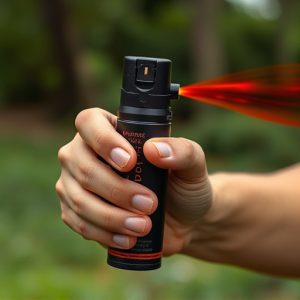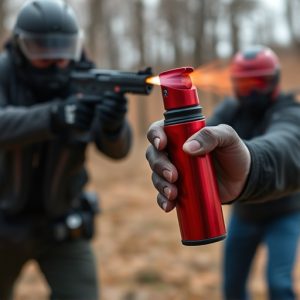Maximizing Pepper Spray Effectiveness: Storage & Replacement Guide
Maintaining pepper spray effectiveness requires understanding its composition, degradation processes…….
Maintaining pepper spray effectiveness requires understanding its composition, degradation processes, and storage best practices. Once opened, pepper spray degrades faster due to air, sunlight, and moisture exposure, significantly shortening its shelf life compared to unopened products. Optimal storage conditions, including temperature control (50-70°F/10-21°C) and humidity minimization, are crucial for law enforcement agencies. Regular inventory checks, testing, and replacement ensure the availability of fresh, potent pepper spray for both professional and self-defense uses, with a focus on staying prepared by managing its lifespan, especially after opening.
“Uncover the essential factors extending the pepper spray shelf life after opening with our comprehensive guide. Delve into the intricate details of understanding its composition, exploring degradation processes, and identifying key influences on its longevity. We demystify optimal storage practices to ensure maximum effectiveness. Learn to recognize signs indicating when it’s time for a replacement, empowering you to make informed decisions regarding your personal or law enforcement grade pepper spray.”
- Understanding Pepper Spray Composition and Its Degradation
- Factors Affecting Pepper Spray Shelf Life After Opening
- Storage Practices for Maximizing Pepper Spray Effectiveness
- When to Replace Your Pepper Spray: Knowing the Signs
Understanding Pepper Spray Composition and Its Degradation
Pepper spray, a potent non-lethal weapon, is designed to incapacitate individuals through the irritation of eyes and respiratory tracts. Comprehending its composition and degradation process is crucial for law enforcement officers and users alike. The active ingredient in most pepper sprays is capsaicin, a chemical derived from chili peppers. This substance is usually suspended in a solution of water and other additives, such as soap or ethanol, to enhance its effectiveness and prevent clumping.
Once opened, pepper spray begins to degrade, affecting its potency and shelf life. Exposure to air, sunlight, and moisture can accelerate this process. The stability of the capsaicin molecule is key in determining the product’s effectiveness. Over time, capsaicin may lose its potency as it undergoes chemical reactions, and the solution can become less effective. Therefore, understanding pepper spray composition and its sensitivity to environmental factors is essential for ensuring optimal performance when needed, especially considering the critical nature of its use in law enforcement operations.
Factors Affecting Pepper Spray Shelf Life After Opening
The pepper spray shelf life after opening is influenced by several factors, including storage conditions and the quality of the product. Unlike unopened units that have a typically longer shelf life, once opened, the chemical composition begins to change due to exposure to air, moisture, and light. Proper storage is key; keeping it in a cool, dry place away from direct sunlight can significantly extend its effectiveness.
Additionally, the type of pepper spray and its active ingredient play a role. Some formulations may degrade faster than others, leading to reduced potency over time. Regular testing or using high-quality products certified for law enforcement use ensures that officers have the full strength of the spray available when needed, maximizing its shelf life after opening.
Storage Practices for Maximizing Pepper Spray Effectiveness
Proper storage practices are essential to maintain the effectiveness and potency of pepper spray, especially once opened. Law enforcement agencies should establish clear guidelines for storing both unopened and used cans to ensure optimal performance when needed. One key factor is temperature control; pepper spray should be stored in a cool, dry place, away from direct sunlight or extreme heat. Ideal storage conditions typically range between 50-70°F (10-21°C), which helps preserve the active ingredients and prolongs its shelf life after opening.
Additionally, maintaining proper humidity levels is crucial. Pepper spray can lose potency if exposed to excessive moisture; thus, a controlled environment with minimal humidity fluctuations is ideal. Unopened cans should be stored in their original packaging until use, while opened containers should be kept in sealed bags or airtight containers to protect against environmental contaminants and potential degradation. Regular inventory checks are recommended to identify any expired or stale stock, ensuring only the most effective pepper spray remains available for duty.
When to Replace Your Pepper Spray: Knowing the Signs
Pepper spray is a crucial tool for law enforcement and self-defense, but like any piece of equipment, it has a limited lifespan, especially once opened. Understanding when to replace your pepper spray, particularly after opening, is essential for its effectiveness and user safety. The Pepper Spray Shelf Life After Opening is a critical factor that cannot be ignored; its potency and performance degrade over time.
Signs that your pepper spray may need replacing include decreased spray intensity, reduced fogging ability, or changes in the chemical composition. If you notice that the spray no longer reaches its claimed range or fails to disrupt an assailant’s vision as advertised, it might be past its prime. Regularly inspecting and testing your pepper spray is vital to ensure you’re prepared for any situation.
Proper storage and understanding of pepper spray’s degradation are essential to maintaining its effectiveness. By following best practices for storage and staying vigilant with replacement, users can ensure they have a reliable self-defense tool ready when needed. Remember, regular maintenance and timely replacement of pepper spray, especially after opening, are key to keeping it potent and ready to protect against unexpected threats.


